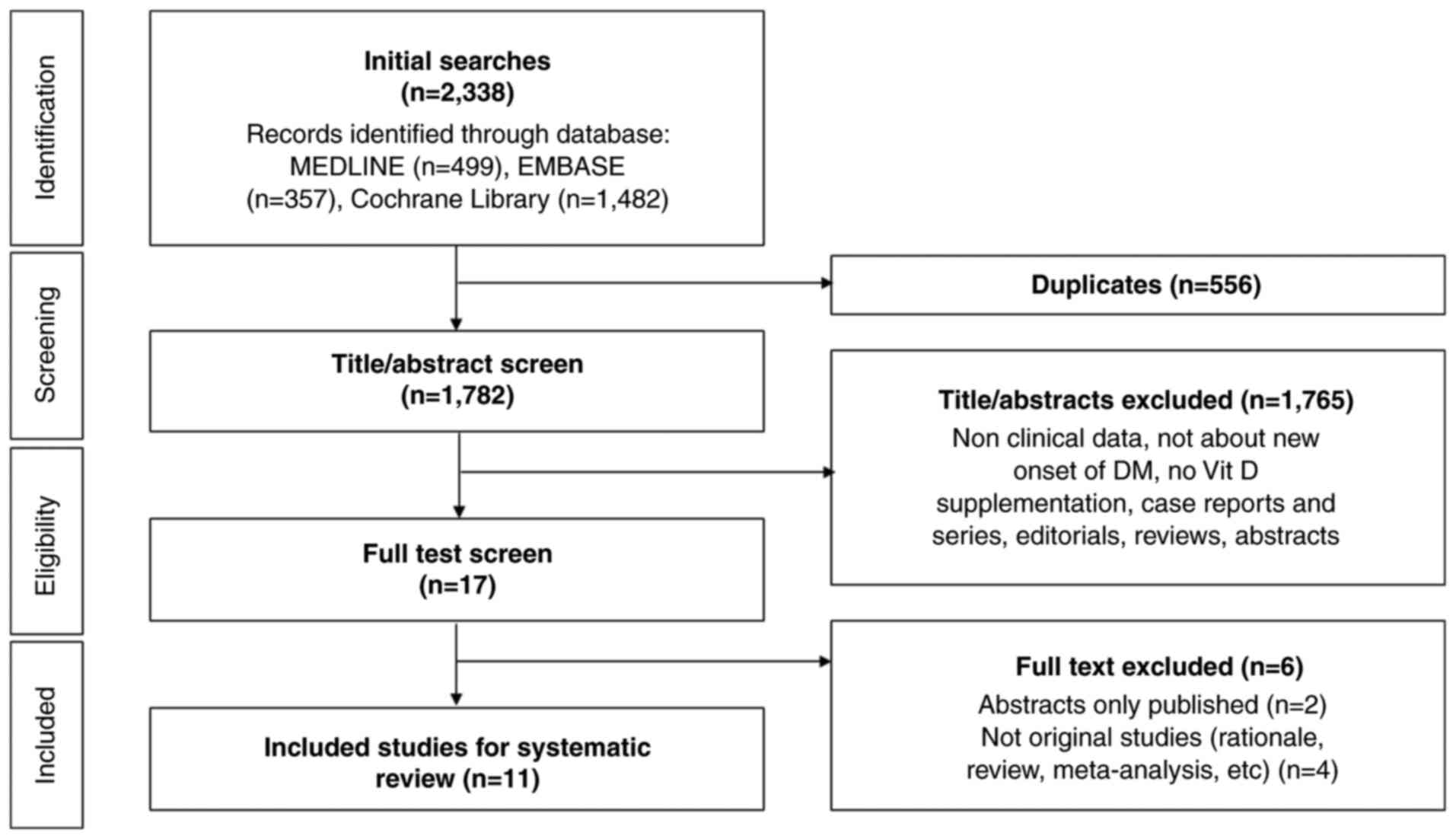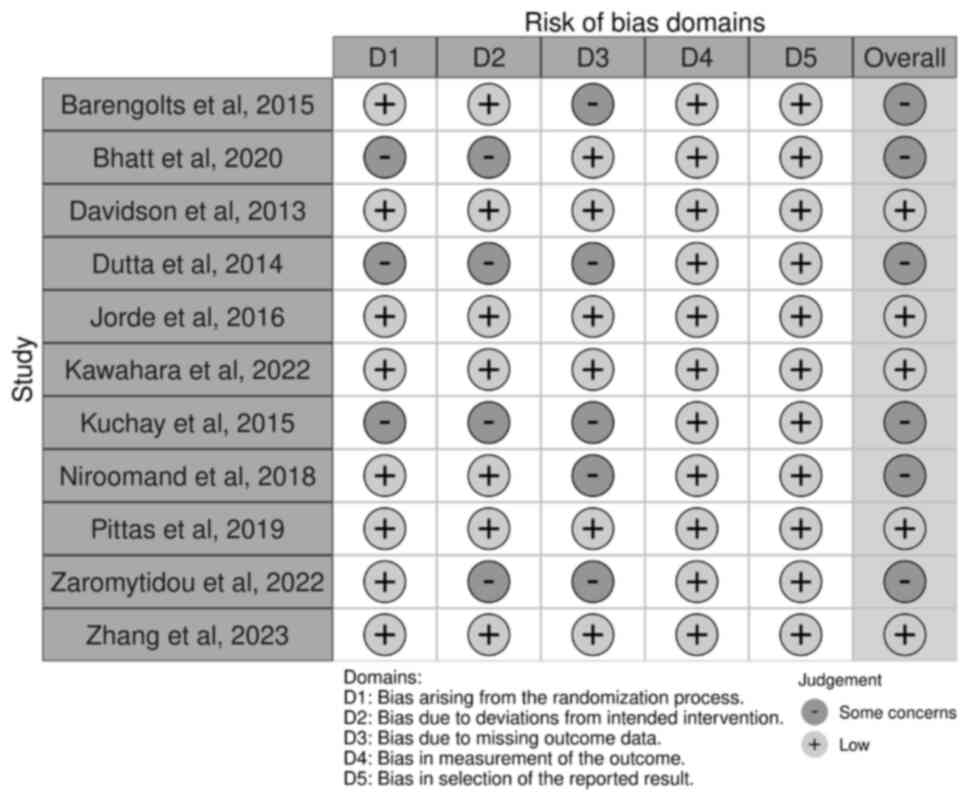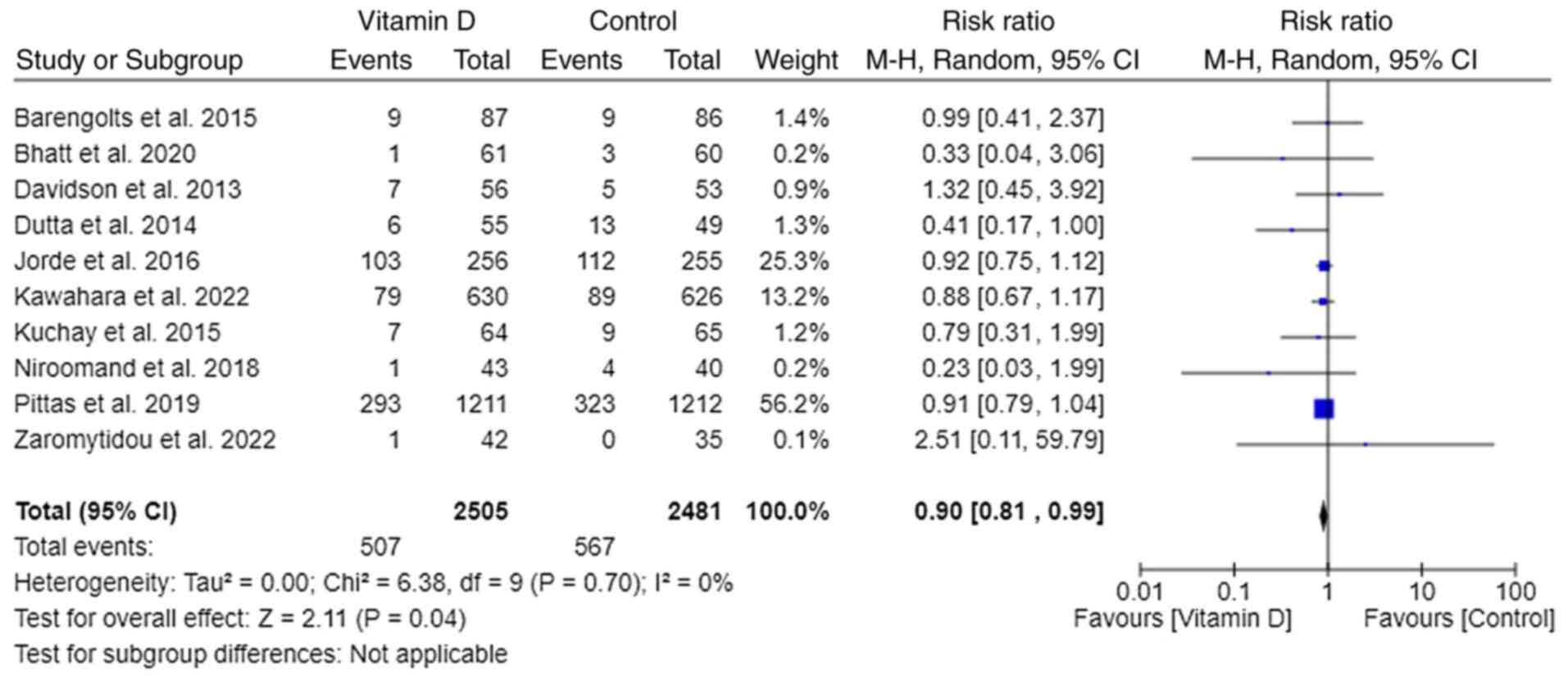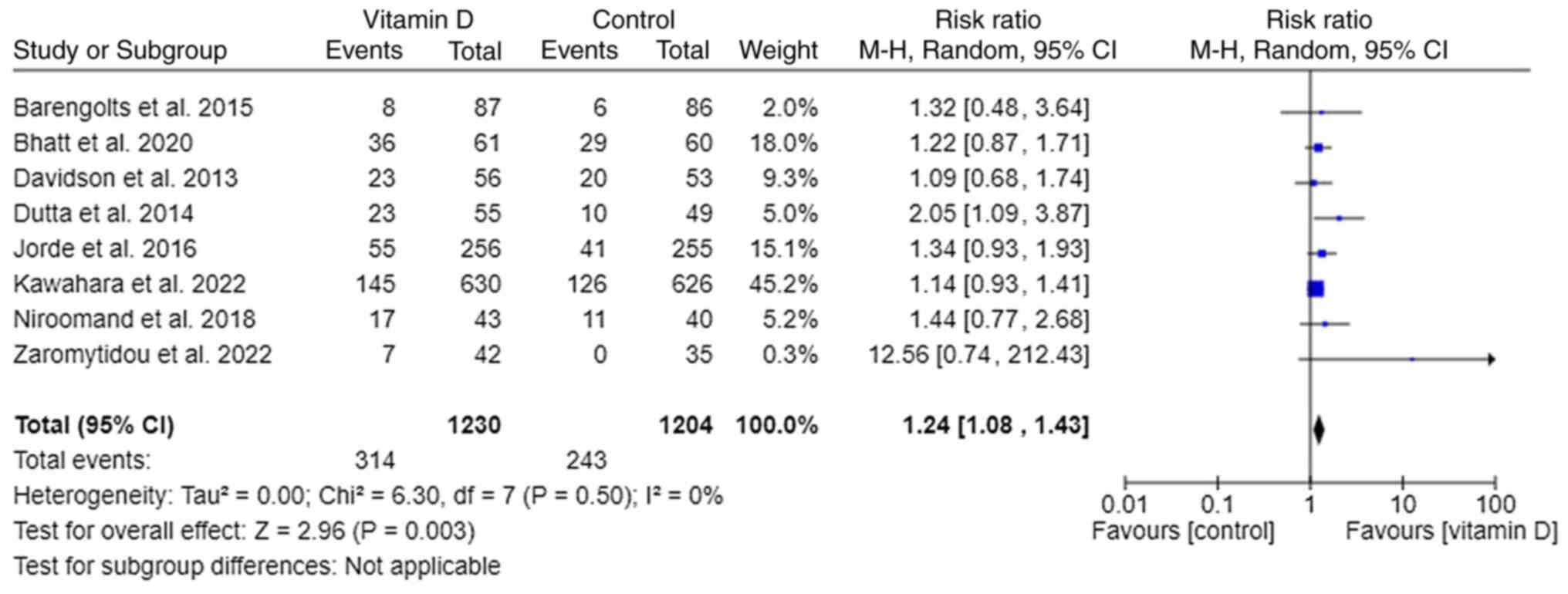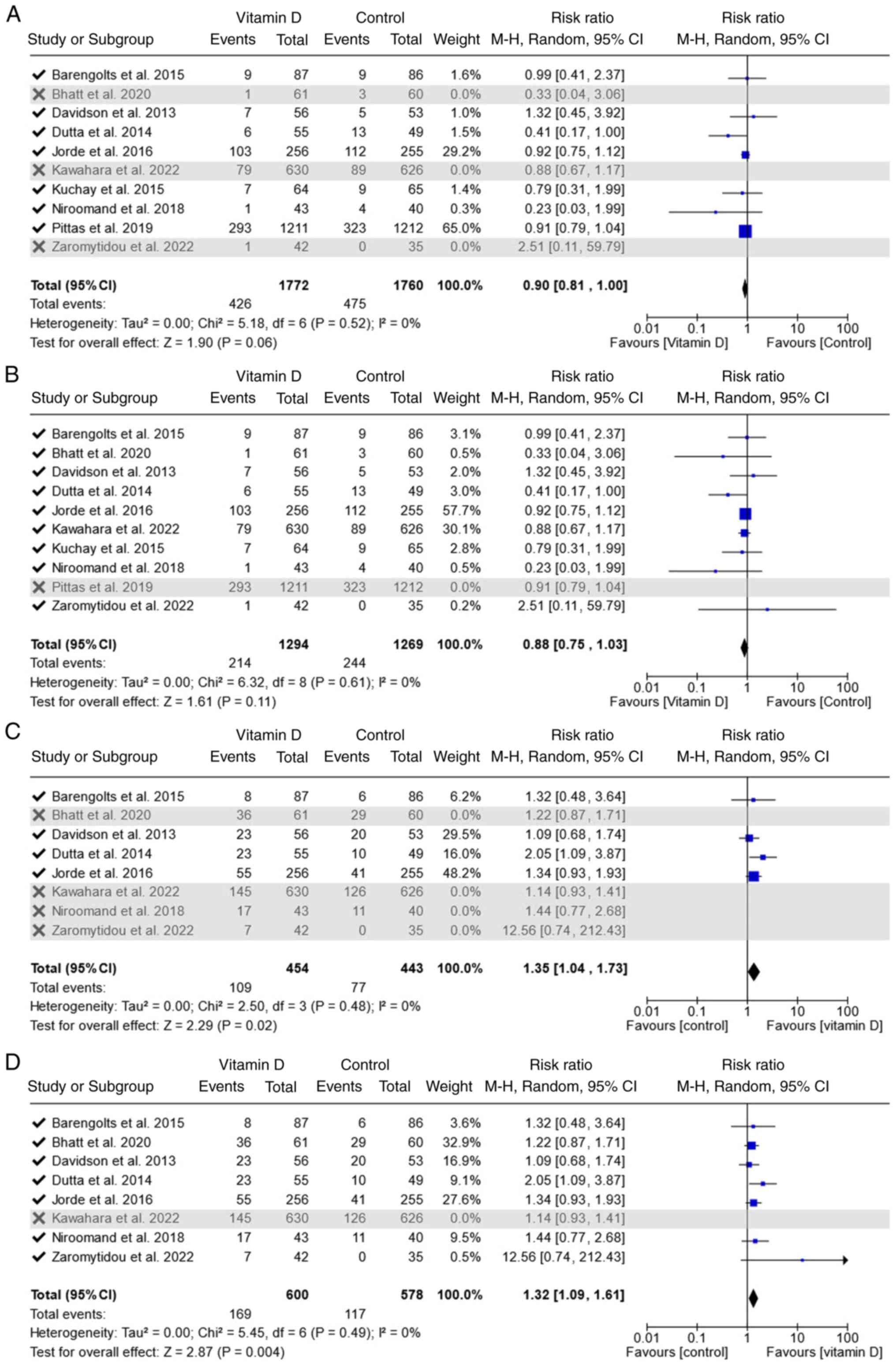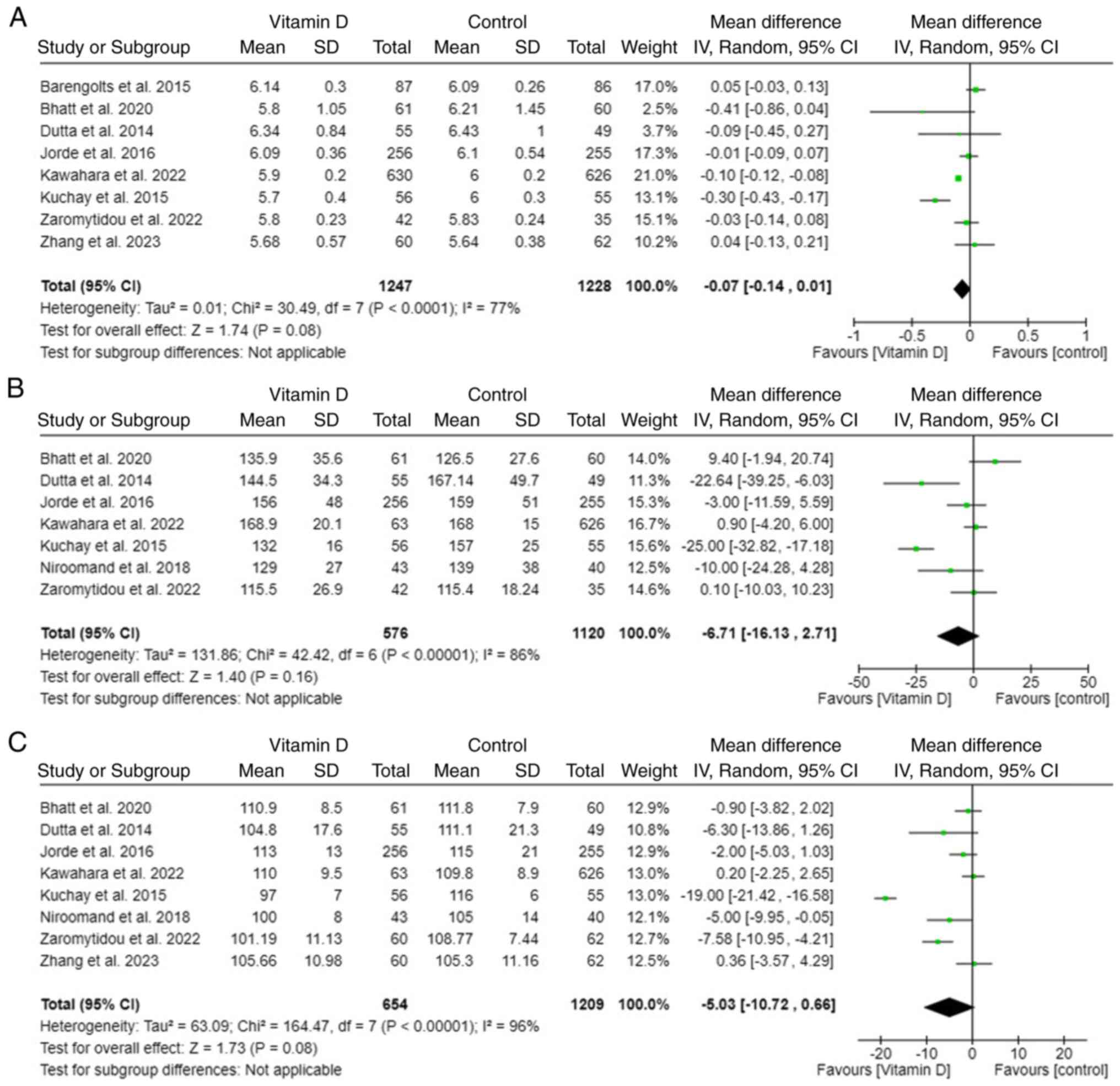Role of vitamin D in prevention of type 2 diabetes mellitus: A systematic review and meta‑analysis
- Authors:
- Published online on: October 8, 2024 https://doi.org/10.3892/etm.2024.12741
- Article Number: 451
-
Copyright: © Sim et al. This is an open access article distributed under the terms of Creative Commons Attribution License.
Abstract
Introduction
The prevalence of diabetes mellitus (DM) is on an upward trajectory, with projections indicating an increase to over 700 million individuals by the year 2045(1). As of 2019, it is estimated that >463 million individuals globally are afflicted with DM, positioning the management and prevention of this condition as a primary global health objective (2). Type 2 DM (T2DM) is characterized by hyperglycemia, insulin resistance and compromised insulin secretion, representing the predominant form of diabetes and accounting for >90% of DM cases worldwide. This condition impacts hundreds of millions globally (3). Despite the significant lifetime risk associated with T2DM, accurately predicting and preventing the disease in the general populace remains a significant challenge.
Vitamin D, encompassing cholecalciferol (vitamin D3) and ergocalciferol (vitamin D2), serves as a precursor to hormones and plays a pivotal role in the regulation of calcium and phosphate metabolism (4). The biosynthesis of vitamin D initiates with the irradiation of 7-dehydrocholesterol in the skin by ultraviolet B radiation under the influence of strong sunlight, constituting the principal mechanism of vitamin D production (5). The intake of vitamin D and its protective effects against T2DM have been the focus of extensive research.
Several strands of evidence suggest a potential role for vitamin D in the prevention of T2DM. First, vitamin D may regulate numerous processes implicated in the initiation of T2DM, including the modulation of calcium ion concentration and the generation of reactive oxygen species (ROS) (6,7). Second, vitamin D is recognized for its role in maintaining normal mitochondrial function, crucial for cellular bioenergetics (8). Lastly, vitamin D has been shown to mitigate inflammation, thereby aiding in the control of insulin resistance (9). Consequently, the proposition that vitamin D mitigates the onset of T2DM can be elucidated by its multifaceted mechanisms of action, a subject that has been rigorously examined within both clinical and basic research spheres.
Nevertheless, the hypothesis that vitamin D status could affect the risk of T2DM, despite its biological plausibility, is met with consistently inconclusive results. The real-world efficacy of vitamin D supplementation in diminishing the incidence of new T2DM cases remains ambiguous, notwithstanding theoretical rationale. This ambiguity underscores the critical necessity to integrate the findings from extant clinical trials, highlighting the imperative to rigorously evaluate the influence of vitamin D consumption on the development of T2DM. Accordingly, the present meta-analysis was designed to amalgamate the outcomes of clinical investigations concerning the impact of vitamin D supplementation on the progression of T2DM.
Materials and methods
Search strategy
A comprehensive search of English-language literature was conducted through MEDLINE (https://pubmed.ncbi.nlm.nih.gov), EMBASE (https://www.embase.com) and the Cochrane Library (https://www.cochranelibrary.com) for studies published from January 2010 to December 2023. The search strategy employed was ‘(diabetes* or hyperglycemia*) and (vitamin D or cholecalciferol* or ergocalciferol*)’, with a restriction to randomized controlled trials.
Study selection criteria
Eligible studies were required to meet the following inclusion criteria: i) Inclusion of an adult population; ii) diagnosis of impaired glucose tolerance, prediabetes, or impaired fasting glucose; iii) investigation of the effect of vitamin D supplementation on the onset of T2DM, conversion to normoglycemia, oral glucose tolerance test, fasting serum glucose (FSG) and hemoglobin A1c (HbA1c) levels; iv) restriction to randomized controlled trials (RCTs). Additionally, studies involving participants diagnosed with T2DM, which also considered combination therapy with other medications, such as calcium supplements, omega-3 fatty acids, or statins, were included. Such studies were specifically selected when they were designed to serve as appropriate control groups, thereby facilitating the examination of the effects of vitamin D. The screening and selection process of the studies for inclusion in the analysis were conducted by two independent reviewers.
To enhance the reliability, and validity of meta-analysis research, the study protocol is registered on the Open Science Framework. The study protocol is available in the Open Science Framework (https://doi.org/10.17605/OSF.IO/XJ3EN).
Quality assessment methodology
To assess the quality of the RCTs, the Cochrane Risk of Bias tool for randomized trials (ROB2) was utilized (10). This tool evaluates five domains of potential bias: The randomization process, the blinding of participants and personnel, the handling of missing outcome data, the completeness of outcome data measurement, and the reporting of selected outcomes. Each study was independently assessed by two reviewers for its risk of bias, categorizing the risk level as ‘high’, ‘some concern’ or ‘low’.
Statistical analysis
Meta-analyses were performed utilizing Review Manager software (RevMan, version 5.4.1; The Cochrane Collaboration, 2020) for statistical analysis. The magnitude of the effect was determined based on the mean difference (MD) along with its 95% confidence interval (CI) for continuous outcomes. For dichotomous outcomes, the risk ratio (RR) with its 95% CI was calculated. An inverse-variance method and Mantel-Haenszel method were applied to combine data for continuous outcomes and dichotomous outcomes, respectively. Heterogeneity among studies was quantified using the I2 statistic, with ≤25% indicating low heterogeneity, 26-50% indicating moderate heterogeneity, and >50% indicating high heterogeneity. Random effects meta-analysis was used due to differences in patient baseline characteristics in each study affecting treatment effectiveness.
Subgroup analyses were undertaken to explore the influence of specific covariates on the outcomes, including body mass index (BMI), ethnicity, baseline vitamin D deficiency, concurrent calcium intake, dosage of vitamin D supplementation, baseline vitamin D levels, and duration of vitamin D intake. Publication bias was evaluated using a funnel plot and Egger's test. Sensitivity analyses by sample size were also conducted to verify the stability of the findings.
Results
Study selection and quality assessment
In the initial phase of the literature search, a total of 2,338 potential studies were identified. The process of study selection, adhering to the Preferred Reporting Items for Systematic Reviews and Meta-Analyses guidelines, is delineated in Fig. 1 (11). Subsequent to the preliminary screening, a total of 556 studies were removed due to duplication. An additional 1,765 studies were deemed ineligible and thus excluded based on an assessment of their titles and abstracts, which indicated a lack of direct relevance to the research query. Upon a more detailed examination, involving the full-text review of the 17 studies preliminarily selected, 6 were further excluded for failing to satisfy the established inclusion criteria (12-17). Consequently, the present systematic review ultimately incorporated 11 studies that conformed to the rigorous selection criteria.
In total, 11 RCTs were included in the final analyses (18-28). Upon evaluating the methodological quality of the included studies, each demonstrated a low risk of bias when appraised utilizing the ROB2 tool for randomized trials. The follow-up duration of all trials ranged from 6 months to 5 years. The risk of bias is shown in Fig. 2. All these trials were conducted on prediabetic patients. The characteristics of the included trials are shown in Tables I and II. A total of 5,221 patients were included in the analyses, 2,619 patients were supplemented with vitamin D and 2,602 patients were assigned to the control group. In total, 9 trials used vitamin D3 (cholecalciferol) (19-22,24-28), 1 trial used vitamin D2 (ergocalciferol), and 1 trial used eldecalcitol, a vitamin analog (23). A total of 10 trials reported the progression of prediabetes to T2DM (18-27) and 8 trials measured regression to normoglycemia (18-23,25,27). Of those 10 trials, 5 trials progressed over 12 months (19,21-23,26), 3 trials included only Indians (19,21,24), 7 trials had mean BMI >30 (18-20,22,25-27), and 3 trials used calcium carbonate or supplements along with vitamin D (19,21,26). The median age of 10 trials was 59.5 years.
Table IDemographic features of randomized controlled trials that evaluated the association between vitamin D supplements and type 2 diabetes included in the meta-analysis. |
Table IICharacteristics of therapeutic interventions of randomized controlled trials included in meta-analysis. |
New onset of T2DM
A total of 10 out of 11 trials reported the progression of prediabetes to T2DM (18-27). Pooled data from all 10 trials reporting in RR revealed that vitamin D supplementation in prediabetes patients decreased the new-onset T2DM by 10% [RR, 0.90; 95% CI, (0.81, 0.99); P=0.04 and I²=0%)] (Fig. 3).
Subgroup analyses were conducted to identify any covariates for between-study heterogeneity. The pooled effect sizes found in each subgroup (based on treatment duration, ethnicity, mean BMI, baseline vitamin D level, inclusion of vitamin D deficiency, median age and vitamin dose) were not significantly different. Among the subgroups, the group that received only vitamin D showed a statistically insignificant difference in the incidence of T2DM compared with the control group [RR, 0.89; 95% CI, (0.71, 1.11); P=0.30]. However, when the analysis included all clinical trials that used a combination of calcium carbonate and vitamin D supplements, a statistically significant difference was observed [RR, 0.89; 95% CI, (0.79, 1.00); P=0.04] (data not shown).
Regression to normoglycemia
A total of 8 out of 11 trials reported the regression of prediabetes to normoglycemia (18-23,25,27). It appeared that supplementing vitamin D to prediabetes patients leads to normoglycemia significantly [RR, 1.24; 95% CI, (1.08, 1.43); P=0.003; I²=0%] (Fig. 4). Subgroup analyses were conducted to identify any covariates for between-study heterogeneity. Pooled effect sizes found in these subgroups did not differ significantly from each other.
Sensitivity analysis
Sensitivity analysis was performed, and the results are illustrated in Fig. 5. The trials were added following the publication year, and since the addition of Pittas et al (26), published in 2019, T2DM RR has changed to significantly lower in Vitamin D group than in the control group [RR, 0.90; 95% CI, (0.81, 1.00); P=0.06] (Fig. 5A). Exclusion of the largest trial (26) didn't affect the significance; it was still marginally significant [RR, 0.88; 95% CI, (0.75, 1.03); P=0.11] (Fig. 5B). In regression to normoglycemia outcomes, RR changed significantly when Jorde et al (22) was added [RR, 1.35; 95% CI, (1.04, 1.73); P=0.02] (Fig. 5C). Exclusion of the largest trial (23) didn't affect the significance; it was still significant [RR, 1.32; 95% CI, (1.09, 1.61); P=0.004] (Fig. 5D).
Secondary outcome
The definition of prediabetes is variant according to the glycemic indices; raised glycosylated HbA1c, 2-h plasma glucose (2OGT) and FSG. All three indices decreased after supplementing vitamin D. All HbA1c, 2OGT, and FSG levels showed no statistically significant reduction in the vitamin D supplement group compared with the control group (Fig. 6).
Publication bias
Visual inspection of the funnel plot revealed relatively symmetrical distribution, indicating the absence of publication bias. The funnel plots for onset of T2DM and regression to normoglycemia are illustrated in Fig. 7A and B, respectively.
Discussion
Vitamin D treatment in prediabetes patients lowers the risk of T2DM and regresses to normal glucose blood levels, as revealed in the present meta-analysis of 11 randomized controlled studies. Treating prediabetes patients with vitamin D had significant effects compared with the control group in the subgroup analyses without significant subgroup differences. It was expected that long-term use of vitamin D would be effective, but the subgroup analysis found that it had no interaction.
The trial, which lasted for 5 years, performed subgroup analysis to examine the effect of vitamin D in subjects with low baseline vitamin D levels of <20 ng/ml (22). However, there was no statistically significant difference according to baseline vitamin D levels. Pittas et al (26), the largest trial, conducted a post-hoc subgroup analysis based on baseline vitamin D level of 12 ng/ml, and only in participants with a baseline vitamin D level <12 ng/ml, the effect of vitamin D lowering T2DM HR was significantly greater compared with the control group. These two trials suggested the possibility of an interaction between baseline vitamin D levels and the effect of vitamin D supplementation on the incidence of T2DM. However, the present subgroup analysis showed no association with this and baseline vitamin D levels.
Patterns of vitamin D deficiency among Indians have been proposed (29). Also, Asian Indians have one of the highest numbers of individuals with pre-diabetes and diabetes among all major ethnic groups (30). The 3 trials were designed to find the effect of vitamin D on prediabetes patients with a population of Indians (19,21,24). The result of the subgroup analysis in this meta-analysis was that there was no interaction with ethnicity. There are not many trials tested on Indians, and Bhatt et al (19) only included females. To find a relation with ethnicity, it needs to be interpreted with caution, and more extensive researches are needed.
Calcium is a common supplement that people take with vitamin D. Depending on the symptoms of the patient, there are several alternative suggestions to take calcium with vitamin D. A recent study showed that whether used alone or in combination, vitamin D and calcium supplementation do not exert meaningful effects on all-cause mortality, cardiovascular mortality, major adverse cardiovascular events or myocardial infarction (31). Moreover, vitamin D administration may worsen the risk of stone formation in patients with hypercalciuria (32). In accordance with the present meta-analysis, vitamin D supplements with calcium may help people with prediabetes avoid developing type 2 diabetes.
An interesting result has been drawn about the BMI. Non-obese patients (BMI <30 kg/m2) had a significant reduction in T2DM while obese patients did not. However, it is controversial whether vitamin D has a relationship with obesity. A different meta-analysis concluded that 25(OH)D level is inversely associated with percentage body fat mass (PFM) but cholecalciferol supplementation had no effect on PFM (33). Another meta-analysis proved that cholecalciferol supplementation decreases the BMI and the waist circumference, but does not statistically affect weight loss (34).
Previous meta-analyses constantly revealed an association between vitamin D supplementation and BMI. A meta-analysis that was published in 2020, included 8 trials and found the benefit of vitamin D supplementation on the prevention of diabetes in non-obese patients (35) [mean BMI <30 kg/m2; RR, 0.73; 95% CI, (0.57-0.92); I2=4%; Pinteraction=0.048]. In a different meta-analysis that was also released in 2020, subgroup analysis was carried out, including the trials that provided vitamin D supplements 1,000 IU/day or less. As a result, patients with a mean baseline BMI <30 kg/m2 reduced the risk of T2DM significantly (36) [RR, 0.68; 95% CI, (0.53-0.89); P=0.005; I2=0%, Pinteraction=0.03]. Only non-obese patients gained benefits from either of the two meta-analyses and proved a significant subgroup difference. However, the present meta-analysis found no interaction between BMI and vitamin D supplementation. The difference of the present meta-analysis from the two previous ones was that in the present meta-analysis, the large trial was considered (23). The Kawahara et al (23) study recruited 1,256 participants and was published in 2022. There should be additional studies needed to identify the possibility that vitamin D supplementation and BMI interact. However, the quality of Kawahara et al (23) study was shown to be favorable through the Cochrane Risk of Bias tool for randomized trials (ROB2) test, thus the results of the present meta-analysis are considered to be reliable.
There are several limitations to be considered. First, the subgroup analyses used the mean data of the trials. For example, the present study followed the median age of the trials, 59.5 years. It was expected that senior patients would benefit from supplementing vitamin D, but there was no advantage for them. The broad age range of the trials could be the reason for it. To determine the relationship depending on the specific age range, more research needs to be conducted. Second, some results of the subgroup analyses should be interpreted cautiously because of the lack of data. There were only three studies using calcium and vitamin D, as well as those that targeted Indians. Third, the study that resulted in no patients who regressed to normoglycemia was included in the present meta-analysis (27). The RR and 95% CI of Zaromytidou et al (27) were extremely high, and the study was conducted with small numbers. Furthermore, it would be the reason for the only asymmetry in the funnel plot.
In conclusion, vitamin D supplement is associated with a decreased risk of T2DM onset and an increase of reversion to normoglycemia in prediabetic patients. Further studies are needed to ensure the detailed effects of vitamin D long-term use, baseline vitamin D levels, BMI and obesity on vitamin D benefits for T2DM.
Acknowledgements
This work was supported by the National Research Foundation of Korea (NRF) grant funded by the Korea government (MSIT) (grant no. RS-2023-00253995).
Funding
Funding: The present study was supported by the research funds for newly appointed professors of Jeonbuk National University in 2022.
Availability of data and materials
The data generated in the present study may be requested from the corresponding author.
Authors' contributions
SML, JH and JK designed the study. GS and YJK have done systematic search and selected studies independently. JK and SML confirmed the authenticity of all the raw data. JH and YJK analyzed the data. GS, YJK and SML drafted the manuscript. JK and JH supervised the study process and revised the manuscript. All authors read and approved the final version of the manuscript.
Ethics approval and consent to participate
Not applicable.
Patient consent for publication
Not applicable.
Competing interests
The authors declare that they have no competing interests.
References
|
Hu Hanquan A and Teo Li Wen MR: Prevalence of diabetic peripheral neuropathy in patients with type 2 diabetes mellitus at a tertiary referral centre in Singapore. Proc Singap Healthc. 30:265–70. 2020. | |
|
American Diabetes Association. Standards of medical care in diabetes-2019 abridged for primary care providers. Clin Diabetes. 37:11–34. 2019.PubMed/NCBI View Article : Google Scholar | |
|
Zheng Y, Ley SH and Hu FB: Global aetiology and epidemiology of type 2 diabetes mellitus and its complications. Nat Rev Endocrinol. 14:88–98. 2018.PubMed/NCBI View Article : Google Scholar | |
|
Kulda V: Vitamin D metabolism. Vnitr Lek. 58:400–404. 2012.PubMed/NCBI(In Czech). | |
|
Bouillon R: Optimal vitamin D supplementation strategies. Endocrine. 56:225–226. 2017.PubMed/NCBI View Article : Google Scholar | |
|
Berridge MJ: Vitamin D: A custodian of cell signalling stability in health and disease. Biochem Soc Trans. 43:349–358. 2015.PubMed/NCBI View Article : Google Scholar | |
|
Berridge MJ: Vitamin D cell signalling in health and disease. Biochem Biophys Res Commun. 460:53–71. 2015.PubMed/NCBI View Article : Google Scholar | |
|
Calton EK, Keane KN and Soares MJ: The potential regulatory role of vitamin D in the bioenergetics of inflammation. Curr Opin Clin Nutr Metab Care. 18:367–373. 2015.PubMed/NCBI View Article : Google Scholar | |
|
Wimalawansa SJ: Vitamin D deficiency is a surrogate marker for visceral fat content, metabolic syndrome, type 2 diabetes and future metabolic complications. J Diabetes Metab Disord Control. 3:6–13. 2016. | |
|
Higgins JPT, Savović J, Page MJ, Elbers RG and Sterne JAC: Assessing risk of bias in a randomized trial. In: Higgins JPT, Thomas J, Chandler J, Cumpston M, Li T, Page MJ and Welch VA (eds). Cochrane Handbook for Systematic Reviews of Interventions. 2nd edition. Wiley-Blackwell, pp205-228, 2019. | |
|
Moher D, Shamseer L, Clarke M, Ghersi D, Liberati A, Petticrew M, Shekelle P and Stewart LA: PRISMA-P Group. Preferred reporting items for systematic review and meta-analysis protocols (PRISMA-P) 2015 statement. Syst Rev. 4(1)2015.PubMed/NCBI View Article : Google Scholar | |
|
Davidson MB, Duran P, Lee ML and Friedman TC: High-dose vitamin D supplementation in people with prediabetes and hypovitaminosis D. Diabetes Care. 36:260–266. 2013.PubMed/NCBI View Article : Google Scholar | |
|
Dutta D, Mondal SA, Choudhuri S, Maisnam I, Hasanoor Reza AH, Bhattacharya B, Chowdhury S and Mukhopadhyay S: Vitamin-D supplementation in prediabetes reduced progression to type 2 diabetes and was associated with decreased insulin resistance and systemic inflammation: an open label randomized prospective study from Eastern India. Diabetes Res Clin Pract. 103:e18–23. 2014.PubMed/NCBI View Article : Google Scholar | |
|
Gonzalez S, Duran P, Friedman T and Davidson M (eds): The effect of six months of vitamin D supplemention in minorities with pre-diabetes and hypovitaminosis D. Journal of investigative medicine: Lippincott Williams & Wilkins 530 Walnut St, Philadelphia, PA 19106-3621 USA, 2012. | |
|
Kawahara T: Eldecalcitol, a vitamin D analog, for diabetes prevention in impaired glucose tolerance (DPVD study). Diabetes. 67 (Suppl 1):S120–LB. 2018. | |
|
Kawahara T, Suzuki G, Inazu T, Mizuno S, Kasagi F, Okada Y and Tanaka Y: Rationale and design of diabetes prevention with active vitamin D (DPVD): A randomised, double-blind, placebo-controlled study. BMJ Open. 6(e011183)2016.PubMed/NCBI View Article : Google Scholar | |
|
Kawahara T, Suzuki G, Inazu T, Mizuno S, Kasagi F, Okada Y and Tanaka Y: DPVD clinical study group. Eldecalcitol, a vitamin D analogue, for diabetes prevention in impaired glucose tolerance: DPVD study. Diabetologia. 61 (Suppl 1)(S78)2018. | |
|
Barengolts E, Manickam B, Eisenberg Y, Akbar A, Kukreja S and Ciubotaru I: Effect of high-dose vitamin D repletion on glycemic control in African-American males with prediabetes and hypovitaminosis D. Endocr Pract. 21:604–612. 2015.PubMed/NCBI View Article : Google Scholar | |
|
Bhatt SP, Misra A, Pandey RM, Upadhyay AD, Gulati S and Singh N: Vitamin D supplementation in overweight/obese Asian Indian women with prediabetes reduces glycemic measures and truncal subcutaneous fat: A 78 weeks randomized placebo-controlled trial (PREVENT-WIN trial). Sci Rep. 10(220)2020.PubMed/NCBI View Article : Google Scholar | |
|
Davidson MB, Duran P, Lee ML and Friedman TC: High-dose vitamin D supplementation in people with prediabetes and hypovitaminosis D. Diabetes Care. 36:260–266. 2013.PubMed/NCBI View Article : Google Scholar | |
|
Dutta D, Mondal SA, Choudhuri S, Maisnam I, Reza AHH, Bhattacharya B, Chowdhury S and Mukhopadhyay S: Vitamin-D supplementation in prediabetes reduced progression to type 2 diabetes and was associated with decreased insulin resistance and systemic inflammation: An open label randomized prospective study from Eastern India. Diabetes Res Clin Pract. 103:e18–e23. 2014.PubMed/NCBI View Article : Google Scholar | |
|
Jorde R, Sollid ST, Svartberg J, Schirmer H, Joakimsen RM, Njølstad I, Fuskevåg OM, Figenschau Y and Hutchinson MY: Vitamin D 20,000 IU per week for five years does not prevent progression from prediabetes to diabetes. J Clin Endocrinol Metab. 101:1647–1655. 2016.PubMed/NCBI View Article : Google Scholar | |
|
Kawahara T, Suzuki G, Mizuno S, Inazu T, Kasagi F, Kawahara C, Okada Y and Tanaka Y: Effect of active vitamin D treatment on development of type 2 diabetes: DPVD randomised controlled trial in Japanese population. BMJ. 377(e066222)2022.PubMed/NCBI View Article : Google Scholar | |
|
Kuchay MS, Laway BA, Bashir MI, Wani AI, Misgar RA and Shah ZA: Effect of vitamin D supplementation on glycemic parameters and progression of prediabetes to diabetes: A 1-year, open-label randomized study. Indian J Endocrinol Metab. 19:387–392. 2015.PubMed/NCBI View Article : Google Scholar | |
|
Niroomand M, Fotouhi A, Irannejad N and Hosseinpanah F: Does high-dose vitamin D supplementation impact insulin resistance and risk of development of diabetes in patients with pre-diabetes? A double-blind randomized clinical trial. Diabetes Res Clin Pract. 148:1–9. 2019.PubMed/NCBI View Article : Google Scholar | |
|
Pittas AG, Dawson-Hughes B, Sheehan P, Ware JH, Knowler WC, Aroda VR, Brodsky I, Ceglia L, Chadha C, Chatterjee R, et al: Vitamin D supplementation and prevention of type 2 diabetes. N Engl J Med. 381:520–530. 2019.PubMed/NCBI View Article : Google Scholar | |
|
Zaromytidou E, Koufakis T, Dimakopoulos G, Drivakou D, Konstantinidou S, Antonopoulou V, Grammatiki M, Manthou E, Iakovou I, Gotzamani-Psarrakou A and Kotsa K: The effect of vitamin D supplementation on glycemic status of elderly people with prediabetes: A 12-month open-label, randomized-controlled study. Expert Rev Clin Pharmacol. 15:89–97. 2022.PubMed/NCBI View Article : Google Scholar | |
|
Zhang D, Zhong X, Cheng C, Su Z, Xue Y, Liu Y, Zhang Y, Feng M, Xu Z, Zhao T, et al: Effect of vitamin D and/or calcium supplementation on pancreatic β-cell function in subjects with prediabetes: A randomized, controlled trial. J Agric Food Chem. 71:347–357. 2023.PubMed/NCBI View Article : Google Scholar | |
|
Aparna P, Muthathal S, Nongkynrih B and Gupta SK: Vitamin D deficiency in India. J Family Med Prim Care. 7:324–330. 2018.PubMed/NCBI View Article : Google Scholar | |
|
Shrivastava U, Misra A, Mohan V, Unnikrishnan R and Bachani D: Obesity, diabetes and cardiovascular diseases in India: Public health challenges. Curr Diabetes Rev. 13:65–80. 2017.PubMed/NCBI View Article : Google Scholar | |
|
Zhang Y, Li Y, Liu J, Wei X, Tan N, Zhang J, Zhang J, Wang W and Wang Y: Association of vitamin D or calcium supplementation with cardiovascular outcomes and mortality: A meta-analysis with trial sequential analysis. J Nutr Health Aging. 25:263–270. 2021.PubMed/NCBI View Article : Google Scholar | |
|
Bargagli M, Ferraro PM, Vittori M, Lombardi G, Gambaro G and Somani B: Calcium and vitamin D supplementation and their association with kidney stone disease: A narrative review. Nutrients. 13(4363)2021.PubMed/NCBI View Article : Google Scholar | |
|
Golzarand M, Hollis BW, Mirmiran P, Wagner CL and Shab-Bidar S: Vitamin D supplementation and body fat mass: A systematic review and meta-analysis. Eur J Clin Nutr. 72:1345–1357. 2018.PubMed/NCBI View Article : Google Scholar | |
|
Perna S: Is vitamin D supplementation useful for weight loss programs? A systematic review and meta-analysis of randomized controlled trials. Medicina (Kaunas). 55(368)2019.PubMed/NCBI View Article : Google Scholar | |
|
Zhang Y, Tan H, Tang J, Li J, Chong W, Hai Y, Feng Y, Lunsford LD, Xu P, Jia D and Fang F: Effects of vitamin D supplementation on prevention of type 2 diabetes in patients with prediabetes: A systematic review and meta-analysis. Diabetes Care. 43:1650–1658. 2020.PubMed/NCBI View Article : Google Scholar | |
|
Barbarawi M, Zayed Y, Barbarawi O, Bala A, Alabdouh A, Gakhal I, Rizk F, Alkasasbeh M, Bachuwa G and Manson JE: Effect of vitamin D supplementation on the incidence of diabetes mellitus. J Clin Endocrinol Metab. 105:2857–2868. 2020.PubMed/NCBI View Article : Google Scholar |



